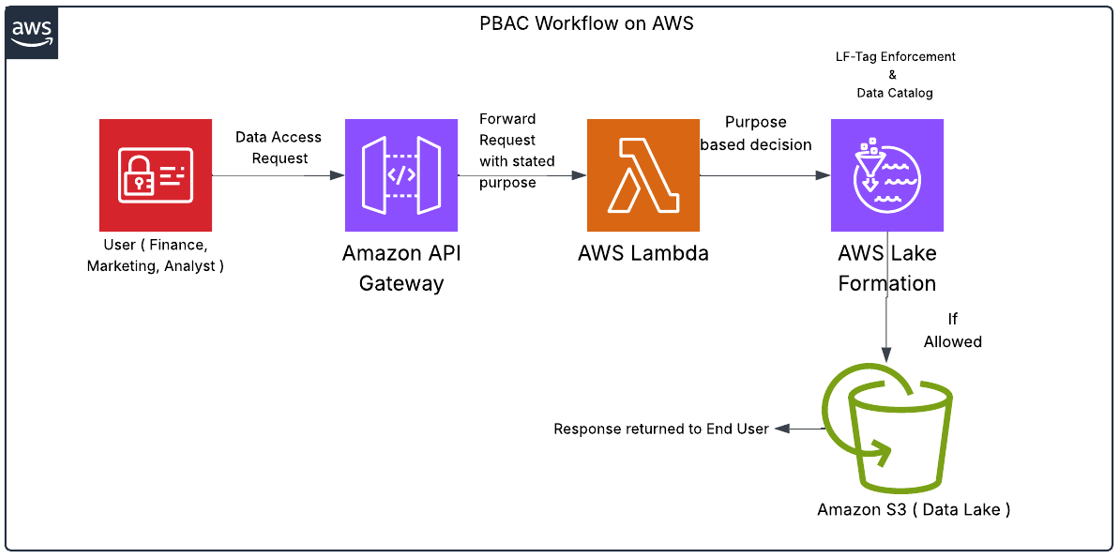From RBAC Chaos to PBAC Control: Data Governance on AWS

What if your data lake became a security labyrinth instead of a data goldmine? For too long, managing access to sensitive data in the cloud has felt like an endless game of patching permissions and untangling a web of static roles. Traditional access models like Role-Based Access Control (RBAC) and Attribute-Based Access Control (ABAC) were the guardians of yesterday, but they are no match for the dynamic, multi-tenant needs of today’s large-scale data environments. In a world where compliance frameworks like GDPR and HIPAA are non-negotiable and data serves as a strategic product, these rigid methods often lead to over-permissioning, security vulnerabilities, and operational headaches.
That’s where Purpose-Based Access Control (PBAC) emerges not just as a better option, but as a strategic evolution in data governance. PBAC shifts the focus from static permissions to dynamic, context-aware access decisions driven by the specific purpose of the request. Instead of simply asking “Who are you?” or “What attributes do you have?”, PBAC also asks “Why do you need this data right now?”.
By incorporating the intended purpose into the decision-making process, PBAC delivers unmatched flexibility, security and compliance ensuring users get only the data necessary for their declared and approved purpose. This approach transforms your data lake from a potential liability into a governed, high-value business asset.
At Ankercloud, we take a research driven approach to implementing PBAC in modern cloud environments, leveraging AWS-native tools and custom policy logic to create secure, purpose-driven access frameworks that scale with your business.
Why Traditional Access Models Fall Short
The core of the problem with older models lies in their rigidity. RBAC, for example, assigns permissions based on static roles. As data environments grow, this can lead to a "role explosion," with dozens or even hundreds of roles to manage, making audits and updates a nightmare. ABAC introduced more flexibility by using attributes, but it too can become complex and unwieldy, requiring constant updates to maintain relevance.
These models struggle to keep pace with the modern reality of:
- Fine-Grained Access: The need for granular control over shared datasets at the column or cell level.
- Compliance Pressures: Strict frameworks like GDPR and HIPAA demand access controls that are provable and dynamically enforceable.
- Data as a Product: The shift to treating data as a product requires scalable, secure, and self-service access to accelerate innovation without compromising security.
PBAC offers a powerful alternative by decoupling access decisions from users, roles, or static attributes. Instead, it evaluates access based on centralized, dynamic policies, allowing for more flexibility, granularity, and maintainability.
A Research-Driven Approach: Implementing PBAC on AWS
Our team at Ankercloud recently explored how Purpose Based Access Control can be implemented in a modern AWS environment using native services. The goal was to evaluate how scalable and secure PBAC can be in real world data architectures. This research driven approach centers around three core AWS components that work in concert to create a robust and dynamic access control system:
- AWS Lake Formation LF-Tags: These tags are a powerful mechanism to define fine-grained access rules directly on your data assets. By applying tags like region=EU or department=Finance to specific tables, databases, or columns, you can create logical groupings that form the basis of your access policies.
- AWS Lambda: This is the brains of the operation. AWS Lambda serves as the dynamic policy engine, evaluating a user's context (e.g., their identity, the time of day, their device) against the LF-Tags of the requested data to make a real-time authorization decision.
- Amazon API Gateway: Acting as the secure entry point, API Gateway routes all data access requests to the Lambda function. This ensures that no data can be accessed without first passing through your centralized policy enforcement point, guaranteeing a single, auditable path for all data queries.
This architecture creates a seamless, secure, and scalable flow: a request comes in, API Gateway sends it to Lambda, Lambda checks the policy against the data's tags, and access is granted or denied all in real-time.
Top Use Cases & Real-World Impact
The power of PBAC truly shines in complex, distributed data environments. Consider a global retail company with departments like Marketing, Finance, and Supply Chain all accessing a shared enterprise data lake. The challenge is ensuring each department has restricted access based on region, role, or data type while meeting strict compliance standards.
- The Traditional Problem: Implementing this with RBAC would require creating dozens of static IAM roles and manually managing views for each department, leading to a high risk of over-permissioned access and administrative overhead.
- The PBAC Solution: With PBAC on AWS, data is tagged using LF-Tags (e.g., department=Marketing, region=EU, data_type=PII). An API Gateway handles incoming requests, and Lambda enforces policies in real-time. For example, a Marketing analyst from the EU requests customer data. PBAC automatically checks their access against the LF-Tags, and if the policy matches, access is granted otherwise, it is denied all without any manual intervention.
This approach is also critical for:
- Healthcare:
Ensuring doctors, researchers, and administrators only have access to specific patient data based on their role, location, or data sensitivity (e.g., genetic data vs. demographic data), aligning perfectly with HIPAA. - Financial Services:
Implementing granular controls for financial data, allowing analysts to view market trends without accessing sensitive customer account details, thereby meeting strict regulatory requirements. - Insurance Domain:
Enforcing purpose-driven access so claims adjusters can view only active claim files relevant to their region, underwriters can access risk assessment data without seeing personal health details, and fraud investigators can analyze flagged cases—supporting compliance with industry regulations and protecting customer privacy.
Basic idea of Implementation of PBAC Workflow in AWS

In AWS, Purpose Based Access Control (PBAC) uses dynamic, context-aware rules to decide who can access which data.
- User Request – A Marketing analyst, Finance officer, or Data analyst sends a query to the data lake through Amazon API Gateway.
- Purpose Evaluation – API Gateway forwards the request to an AWS Lambda purpose based engine, which checks:
- User context (identity, department, region, time, device)
- LF-Tags on the requested data (e.g., department=Finance, region=EU, data_type=PII) in AWS Lake Formation
- User context (identity, department, region, time, device)
- Decision – Lambda compares the user’s attributes to the LF-Tag policy:
- Match → Access granted
- No match → Access denied
- Match → Access granted
- Data Delivery – If approved, Lake Formation grants access to the dataset stored in Amazon S3 or queried via the Glue Data Catalog.
- Audit & Monitoring – Every decision is logged in CloudWatch and CloudTrail for compliance tracking (e.g., GDPR, HIPAA).
Example:
- A Marketing analyst in the EU requests customer purchase data. The Lambda engine checks that their department and region match the LF-Tags on the dataset. If tags match (department=Marketing, region=EU), they get access; if not, the request is denied—no manual intervention needed.
The Path to Modern Data Access: How Ankercloud Helps
Embracing PBAC is a strategic move, but its implementation requires deep expertise in modern cloud architecture, data governance, and security best practices. At Ankercloud, we don't just explore these solutions, we build them. We bring a proven, research-driven approach to help businesses transition from outdated access models to a dynamic and secure PBAC framework.
Our specialized services include:
- Strategic Consulting: We help you define your data governance and security objectives, translating them into a clear Purpose Based Access Control (PBAC) roadmap.
- Architecture & Implementation: We design and deploy the entire PBAC architecture on AWS, leveraging native services like Lake Formation, Lambda, and API Gateway for a scalable and secure solution.
- Custom Purpose Engine Development: We build and optimize your dynamic purpose evaluation engine, ensuring it's robust, efficient, and fully aligned with your business logic.
- Continuous Governance: We provide ongoing support to monitor, audit, and evolve your PBAC rules, ensuring your data remains secure and compliant as your business grows.
Our approach is rooted in continuous growth and learning. Big thanks to my team at Ankercloud for their dedication to exploring and building innovative solutions like this.
The future of business is autonomous, adaptive, and intelligent. Purpose Based Access Control ( PBAC) is the key to unlocking this potential securely. It is time to move beyond static, brittle access controls and empower your teams with safe, governed, and purpose-driven data access.
Ready to modernize your data access strategy?
Partner with Ankercloud to implement a cutting-edge PBAC solution that fortifies your data lake and accelerates your innovation. Contact us today.


